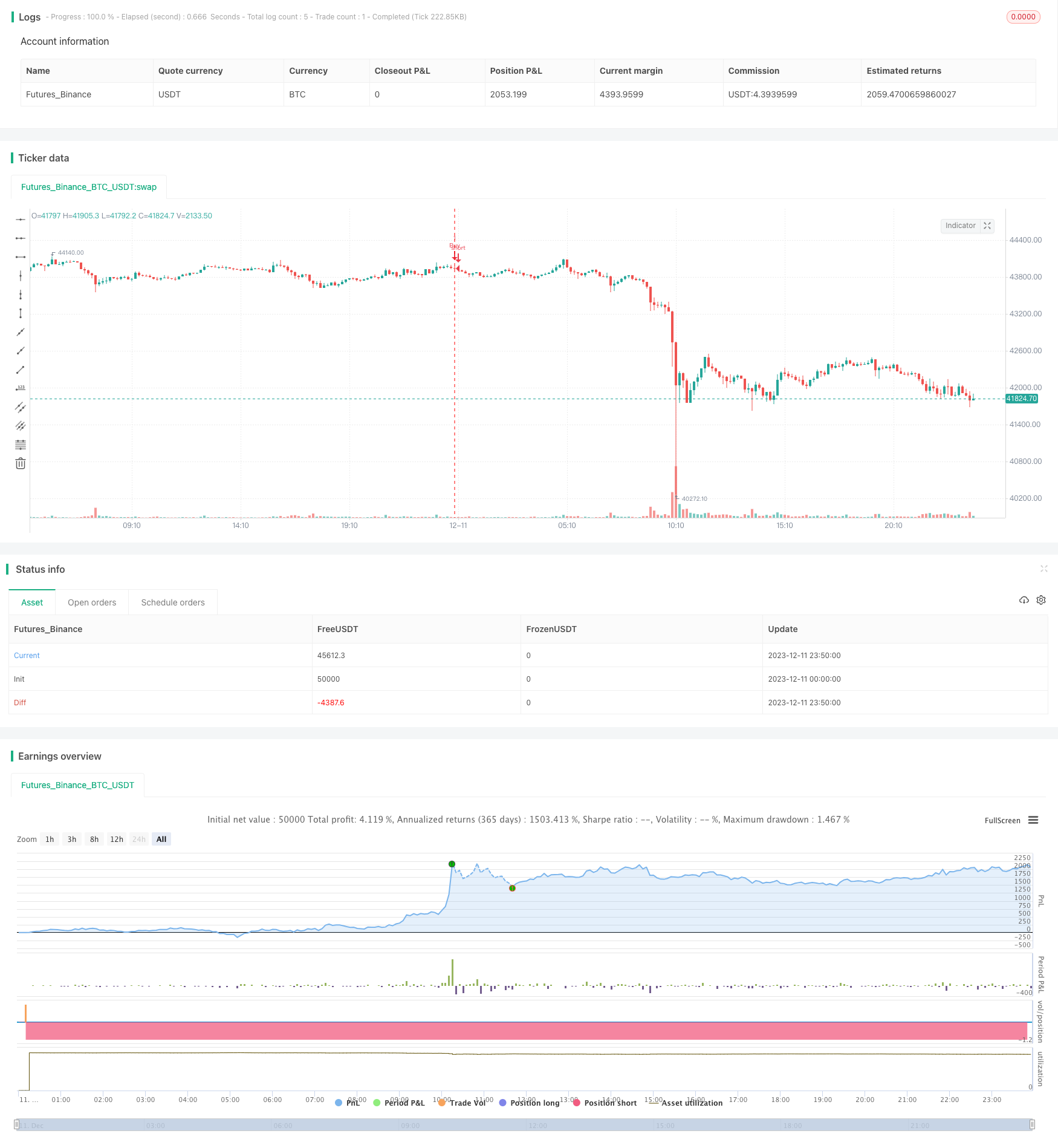
概述
震荡突破策略是一个利用价格震荡形态,在价格突破关键支撑或阻力位时进行买卖操作的策略。该策略结合多种技术指标识别关键交易机会。
策略原理
该策略主要基于布林带中线、48日简单移动平均线(SMA)、MACD和ADX四个技术指标。具体逻辑是:
当收盘价上穿或下穿48日SMA时,考虑交易机会;
当收盘价突破布林带中线时,作为进场信号;
MACD要大于或小于0,作为确定趋势方向的辅助指标;
ADX要大于25,以过滤掉非趋势行情。
满足以上四个条件时,做多或做空。
策略优势
这是一个结合趋势和震荡指标的策略。其主要优势有:
48日SMA过滤掉过度频繁交易,锁定中长线趋势;
布林带中线突破把握关键支撑阻力突破点,具有很强的止损功能;
MACD判断大趋势方向,避免逆势交易;
ADX过滤非趋势市场,提高策略胜率。
综上,该策略在控制交易频率、把握关键点、判断趋势和过滤无效行情等多个方面做了优化,胜率较高。
策略风险
该策略主要存在以下风险:
震荡市场中,布林带中线频繁触发交易机会,可能过度交易;
ADX指标在判断趋势和无效行情时,也存在一定误差;
回撤风险较大,适合有一定风险承受能力的投资者。
策略优化
该策略可从以下几个方面进行进一步优化:
增加ATR指标,设定止损位,减小单笔止损;
优化布林带参数,降低中线触发频率;
增加交易量或趋势强度指标判断趋势强弱,避免弱势逆转。
总结
综上所述,该震荡突破策略整体较为成熟,有效把握震荡行情中的关键交易点。它结合趋势和震荡指标,把握风险与收益之间的平衡。通过进一步优化,可望获得更稳定的超额收益。
策略源码
/*backtest
start: 2023-12-11 00:00:00
end: 2023-12-12 00:00:00
period: 10m
basePeriod: 1m
exchanges: [{"eid":"Futures_Binance","currency":"BTC_USDT"}]
*/
// This source code is subject to the terms of the Mozilla Public License 2.0 at https://mozilla.org/MPL/2.0/
// © 03.freeman
//Volatility Traders Minds Strategy (VTM Strategy)
//I found this startegy on internet, with a video explaingin how it works.
//Conditions for entry:
//1 - Candles must to be above or bellow the 48 MA (Yellow line)
//2 - Candles must to break the middle of bollinger bands
//3 - Macd must to be above or bellow zero level;
//4 - ADX must to be above 25 level
//@version=4
strategy("Volatility Traders Minds Strategy (VTM Strategy)", shorttitle="VTM",overlay=true)
source = input(close)
//MA
ma48 = sma(source,48)
//MACD
fastLength = input(12)
slowlength = input(26)
MACDLength = input(9)
MACD = ema(source, fastLength) - ema(source, slowlength)
aMACD = ema(MACD, MACDLength)
delta = MACD - aMACD
//BB
length = input(20, minval=1)
mult = input(2.0, minval=0.001, maxval=50)
basis = sma(source, length)
dev = mult * stdev(source, length)
upper = basis + dev
lower = basis - dev
//ADX
adxThreshold = input(title="ADX Threshold", type=input.integer, defval=25, minval=1)
adxlen = input(14, title="ADX Smoothing")
dilen = input(14, title="DI Length")
dirmov(len) =>
up = change(high)
down = -change(low)
plusDM = na(up) ? na : (up > down and up > 0 ? up : 0)
minusDM = na(down) ? na : (down > up and down > 0 ? down : 0)
truerange = rma(tr, len)
plus = fixnan(100 * rma(plusDM, len) / truerange)
minus = fixnan(100 * rma(minusDM, len) / truerange)
[plus, minus]
adx(dilen, adxlen) =>
[plus, minus] = dirmov(dilen)
sum = plus + minus
adx = 100 * rma(abs(plus - minus) / (sum == 0 ? 1 : sum), adxlen)
sig = adx(dilen, adxlen)
// Strategy: (Thanks to JayRogers)
// === STRATEGY RELATED INPUTS ===
//tradeInvert = input(defval = false, title = "Invert Trade Direction?")
// the risk management inputs
inpTakeProfit = input(defval = 0, title = "Take Profit Points", minval = 0)
inpStopLoss = input(defval = 0, title = "Stop Loss Points", minval = 0)
inpTrailStop = input(defval = 0, title = "Trailing Stop Loss Points", minval = 0)
inpTrailOffset = input(defval = 0, title = "Trailing Stop Loss Offset Points", minval = 0)
// === RISK MANAGEMENT VALUE PREP ===
// if an input is less than 1, assuming not wanted so we assign 'na' value to disable it.
useTakeProfit = inpTakeProfit >= 1 ? inpTakeProfit : na
useStopLoss = inpStopLoss >= 1 ? inpStopLoss : na
useTrailStop = inpTrailStop >= 1 ? inpTrailStop : na
useTrailOffset = inpTrailOffset >= 1 ? inpTrailOffset : na
// === STRATEGY - LONG POSITION EXECUTION ===
enterLong() => close>ma48 and close>basis and delta>0 and sig>adxThreshold // functions can be used to wrap up and work out complex conditions
//exitLong() => jaw>teeth or jaw>lips or teeth>lips
strategy.entry(id = "Buy", long = true, when = enterLong() ) // use function or simple condition to decide when to get in
//strategy.close(id = "Buy", when = exitLong() ) // ...and when to get out
// === STRATEGY - SHORT POSITION EXECUTION ===
enterShort() => close<ma48 and close<basis and delta<0 and sig>adxThreshold
//exitShort() => jaw<teeth or jaw<lips or teeth<lips
strategy.entry(id = "Sell", long = false, when = enterShort())
//strategy.close(id = "Sell", when = exitShort() )
// === STRATEGY RISK MANAGEMENT EXECUTION ===
// finally, make use of all the earlier values we got prepped
strategy.exit("Exit Buy", from_entry = "Buy", profit = useTakeProfit, loss = useStopLoss, trail_points = useTrailStop, trail_offset = useTrailOffset)
strategy.exit("Exit Sell", from_entry = "Sell", profit = useTakeProfit, loss = useStopLoss, trail_points = useTrailStop, trail_offset = useTrailOffset)
// === Backtesting Dates === thanks to Trost
testPeriodSwitch = input(false, "Custom Backtesting Dates")
testStartYear = input(2020, "Backtest Start Year")
testStartMonth = input(1, "Backtest Start Month")
testStartDay = input(1, "Backtest Start Day")
testStartHour = input(0, "Backtest Start Hour")
testPeriodStart = timestamp(testStartYear,testStartMonth,testStartDay,testStartHour,0)
testStopYear = input(2020, "Backtest Stop Year")
testStopMonth = input(12, "Backtest Stop Month")
testStopDay = input(31, "Backtest Stop Day")
testStopHour = input(23, "Backtest Stop Hour")
testPeriodStop = timestamp(testStopYear,testStopMonth,testStopDay,testStopHour,0)
testPeriod() =>
time >= testPeriodStart and time <= testPeriodStop ? true : false
isPeriod = testPeriodSwitch == true ? testPeriod() : true
// === /END
if not isPeriod
strategy.cancel_all()
strategy.close_all()